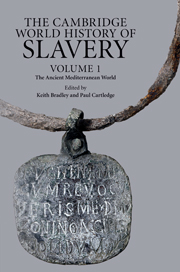Book contents
- Frontmatter
- Contents
- Series editors' introduction
- List of figures
- Acknowledgements
- Introduction
- 1 Slavery in the ancient Near East
- 2 Slaves in Greek literary culture
- 3 Classical Athens
- 4 The Helots: a contemporary review
- 5 Slavery and economy in the Greek world
- 6 The slave supply in classical Greece
- 7 Slavery and the Greek family
- 8 Resistance among chattel slaves in the classical Greek world
- 9 Archaeology and Greek slavery
- 10 Slavery in the Hellenistic world
- 11 Slavery and Roman literary culture
- 12 Slavery in the Roman Republic
- 13 Slavery Under the Principate
- 14 The Roman slave supply
- 15 Slave labour and Roman society
- 16 Slavery and the Roman family
- 17 Resisting slavery at Rome
- 18 Slavery and Roman material culture
- 19 Slavery and Roman law
- 20 Slavery and the Jews
- 21 Slavery and the rise of Christianity
- 22 Slavery in the late Roman world
- Bibliography
- General index
- Index of ancient passages cited
- Index of inscriptions and papyri
- Index of Jewish and Christian Literature Cited
20 - Slavery and the Jews
Published online by Cambridge University Press: 28 September 2011
- Frontmatter
- Contents
- Series editors' introduction
- List of figures
- Acknowledgements
- Introduction
- 1 Slavery in the ancient Near East
- 2 Slaves in Greek literary culture
- 3 Classical Athens
- 4 The Helots: a contemporary review
- 5 Slavery and economy in the Greek world
- 6 The slave supply in classical Greece
- 7 Slavery and the Greek family
- 8 Resistance among chattel slaves in the classical Greek world
- 9 Archaeology and Greek slavery
- 10 Slavery in the Hellenistic world
- 11 Slavery and Roman literary culture
- 12 Slavery in the Roman Republic
- 13 Slavery Under the Principate
- 14 The Roman slave supply
- 15 Slave labour and Roman society
- 16 Slavery and the Roman family
- 17 Resisting slavery at Rome
- 18 Slavery and Roman material culture
- 19 Slavery and Roman law
- 20 Slavery and the Jews
- 21 Slavery and the rise of Christianity
- 22 Slavery in the late Roman world
- Bibliography
- General index
- Index of ancient passages cited
- Index of inscriptions and papyri
- Index of Jewish and Christian Literature Cited
Summary
INTRODUCTION
Although mass (chattel) slavery was a specifically Roman phenomenon in antiquity, Jews do not seem to have been less affected by this common and all-pervasive institution than Romans, Greeks and other provincials in whose immediate environment they lived. Ancient Jewish literary sources suggest that Jews were both slaves and slaveholders in antiquity, and that slavery had a major impact on almost all areas of Jewish daily life, whether in Hellenistic and Roman Palestine or in the Mediterranean Diaspora. The phenomenon of slavery shows how and to what extent Jews were part of Greco-Roman society while at the same time maintaining their biblical roots. It is therefore of particular interest to examine similarities as well as differences between the Jewish and Greco-Roman discourse on slavery to determine whether there was a particularly Jewish perspective and approach.
This chapter will focus on the Jewish experience and rhetoric of slavery from post-exilic to Roman imperial times and late antiquity (fifth century bc to fifth century ad). Previous scholars have usually assumed that slavery was insignificant in ancient Judaism of the post-biblical period. Since the Hebrew Bible refers to Jewish slaves as temporary bondsmen who are to be released in the seventh or Sabbatical Year (cf. Exod. 21:2–3; Lev. 25:40–41; Deut. 15:12), it was commonly assumed that Jews could not be proper slaves of Jews and that Jewish slaveholders treated their gentile slaves as slaves only.
- Type
- Chapter
- Information
- The Cambridge World History of Slavery , pp. 438 - 455Publisher: Cambridge University PressPrint publication year: 2011
- 3
- Cited by

